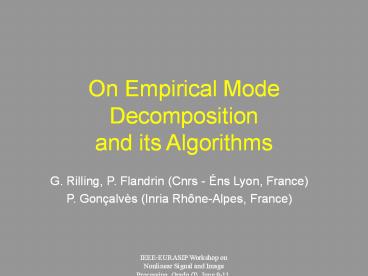On Empirical Mode Decomposition and its Algorithms PowerPoint PPT Presentation
Title: On Empirical Mode Decomposition and its Algorithms
1
On Empirical Mode Decomposition and its
Algorithms
- G. Rilling, P. Flandrin (Cnrs - Éns Lyon, France)
- P. Gonçalvès (Inria Rhône-Alpes, France)
2
outline
- Empirical Mode Decomposition (EMD) basics
- examples
- algorithmic issues
- elements of performance evaluation
- perspectives
3
basic idea
- multimodal signal fast oscillations on the
top of slower oscillations - Empirical Mode Decomposition (Huang)
- identify locally the fastest oscillation
- substract to the signal and iterate on the
residual - data-driven method, locally adaptive and
multiscale
4
Huangs algorithm
- compute lower and upper envelopes from
interpolations between extrema - substract mean envelope from signal
- iterate until mean envelope 0 and extrema
zero-crossings 1 - substract the obtained Intrinsic Mode Function
(IMF) from signal and iterate on residual
5
how EMD works
6
(No Transcript)
7
(No Transcript)
8
(No Transcript)
9
(No Transcript)
10
(No Transcript)
11
(No Transcript)
12
(No Transcript)
13
(No Transcript)
14
(No Transcript)
15
(No Transcript)
16
(No Transcript)
17
(No Transcript)
18
(No Transcript)
19
(No Transcript)
20
(No Transcript)
21
(No Transcript)
22
(No Transcript)
23
(No Transcript)
24
(No Transcript)
25
(No Transcript)
26
(No Transcript)
27
(No Transcript)
28
(No Transcript)
29
(No Transcript)
30
(No Transcript)
31
(No Transcript)
32
(No Transcript)
33
(No Transcript)
34
(No Transcript)
35
(No Transcript)
36
(No Transcript)
37
(No Transcript)
38
(No Transcript)
39
(No Transcript)
40
(No Transcript)
41
(No Transcript)
42
(No Transcript)
43
(No Transcript)
44
(No Transcript)
45
(No Transcript)
46
(No Transcript)
47
(No Transcript)
48
(No Transcript)
49
(No Transcript)
50
(No Transcript)
51
(No Transcript)
52
(No Transcript)
53
(No Transcript)
54
(No Transcript)
55
(No Transcript)
56
(No Transcript)
57
(No Transcript)
58
(No Transcript)
59
(No Transcript)
60
(No Transcript)
61
(No Transcript)
62
(No Transcript)
63
(No Transcript)
64
(No Transcript)
65
(No Transcript)
66
(No Transcript)
67
(No Transcript)
68
(No Transcript)
69
(No Transcript)
70
(No Transcript)
71
(No Transcript)
72
(No Transcript)
73
(No Transcript)
74
(No Transcript)
75
(No Transcript)
76
(No Transcript)
77
(No Transcript)
78
(No Transcript)
79
(No Transcript)
80
(No Transcript)
81
(No Transcript)
82
EMD and AM-FM signals
- quasi-monochromatic harmonic oscillations
- self-adaptive time-variant filtering
- example 2 sinus FM 1 Gaussian wave packet
83
EMD
84
time-frequency signature
85
time-frequency signature
86
time-frequency signature
87
time-frequency signature
88
nonlinear oscillations
- IMF ? Fourier mode and, in nonlinear situations,
1 IMF many Fourier modes - example 1 HF triangle 1 MF tone 1 LF
triangle
89
EMD
90
issues
- algorithm ?
- intuitive but ad-hoc procedure, not unique
- several user-controlled tunings
- performance ?
- difficult evaluation since no analytical
definition - numerical simulations
91
algorithmic issues
- interpolation
- type ? cubic splines
- border effects ? mirror symmetry
- stopping criteria
- mean zero ? 2 thresholds
- variation 1 local EMD
- computational burden
- about log2 N IMF s for N data points
- variation 2 on-line EMD
92
performance evaluation
- extensive numerical simulations
- deterministic framework
- importance of sampling
- ability to resolve multicomponent signals
- a complement to stochastic studies
- noisy signals fractional Gaussian noise
- PF et al., IEEE Sig. Proc. Lett., to appear
93
EMD of fractional Gaussian noise
94
1. EMD and (tone) sampling
95
case 1 oversampling
96
equal height maxima
97
constant upper envelope
98
equal height minima
99
constant lower envelope
100
zero mean tone IMF
101
case 2 moderate sampling
102
fluctuating maxima
103
modulated upper envelope
104
fluctuating minima
105
modulated lower envelope
106
non zero mean tone ? IMF
107
experiment 1
- 256 points tone, with 0 f 1/2
- error normalized L2 distance comparing tone vs.
IMF 1 - minimum when 1/f even multiple of the sampling
period
108
experiment 2
- 256 points tones, with 0 f1 1/2 and f2 f1
- error weighted normalized L2 distance comparing
tone 1 vs. IMF 1, and tone 2 vs. maxIMF k, k
2
109
experiment 3
- intertwining of amplitude ratio, sampling rate
and frequency spacing - dominant effect when f1 1/4 constant-Q
(wavelet-like) confusion band
110
concluding remarks
- EMD is an appealing data-driven and multiscale
technique - spontaneous dyadic filterbank structure in
stationary situations, stochastic (fGn) or
not (tones) - EMD defined as output of an algorithm
theoretical framework beyond numerical
simulations?
111
(p)reprints, Matlab codes and demoswww.ens-ly
on.fr/flandrin/emd.html

